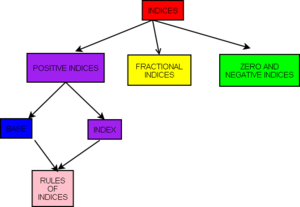Lesson 1: Bases and Indices
Contents
BASES AND INDICES
Introduction
In our earlier studies, we became conversant with the expression of numbers in their standard forms.Also multiplication, addition and substraction are some mathematical terms we applied in solving some numerical problems.In this lesson we will study factors and extend this to bases and indices.
Lesson Contents
In our previous studies, we learnt that large numbers can be broken down into smaller forms known as factors. As examples, we know that:
- 64=2x2x2x2x2x2=26
- 81=3x3x3x3=34
In (1) the six 2s are factors of 64; while the four 3s in (2) are factors of 81. From (1) 2 is called the base while 6 is the index. Likewise in (2) 3 is the base and 4 is defined as the index. From this description we safely say that: 26and 34 are the index forms of 64 and 81. By extension, a3= axaxa and in general, am= axa.....to m factors. 'a' is called the base while m is referred to as index. Index is the same as 'power' or 'exponent'.
Rules for working with Indices
We will now derive the 3 basic rules for working with indices that are are positive integers. *Note that positive integers are numbers such as 1, 2, 3, 4....Let us now have a close look at these expressions: (axa)x (axaxaxa) = axaxaxaxaxa
- a2 x a4 = a6. The index on the hand side of the equation is obtained by adding the indices on the left hand side as: 2+4 = 6. A second example will make this clearer. Have a look at these: (bxbxb) x (bxbxbxb) = bxbxbxbxbxbxb.This is the same as writing b3 x b4 = b7 .
- However, b3+4 = b7 (summing indices). Therefore, b3 x b4 = b3+4 = b7. Hence in general, we can state that:
- when numbers in index form having the same base are multiplied,the product is obtained by the base raised to the sum of the indices. This leads us to the first Rule expressed as:
- RULE 1: am x an = am+n
We already know that: 2/2 = 1: a/a = b/b = 1: axa/axa = 1
Now, let us consider the following expressions which are divisions involving indices:
1. a4/a2 = axaxaxa/ axa = axa x (axa)/(axa) = axa = a2.
You will notice that, 4 - 2 = 2. i.e. subtracting indices, which shows that: a4/a2 = a4-2 =
a2.
2. b10/b2 = bxbxbxbxbxbxbxbxbxb/bxb = bxbxbxbxbxbxbxb = b8
- Note that 10 - 2 = 8 (subtracting indices) Thus, we can safely deduce that when index numbers having the same base are divided, the result is obtained as the base raised to the difference of their indices. This is our second Rule written as:
- Rule 2 : am/an = am-n
Multiplication of indices presents us with the third rule.Hence let us consider this case of multiplication; y4 x y4 x y4 = (y4)3 =y12. However, you will notice that, (y4)3 = y4x3.(multiplying indices).Therefore,we can deduce the third law to be generally of the form:
- Rule 3: (ym)n = ymn
- am x an = am+n
- am/an = am-n
- (ym)n = ymn
Solutions To Assignments
|
Click arrow to show solutions to assignments |
|---|
|
ONE
TWO
THREE
|
Makoki 15:34, 26 February 2007 (CET)
